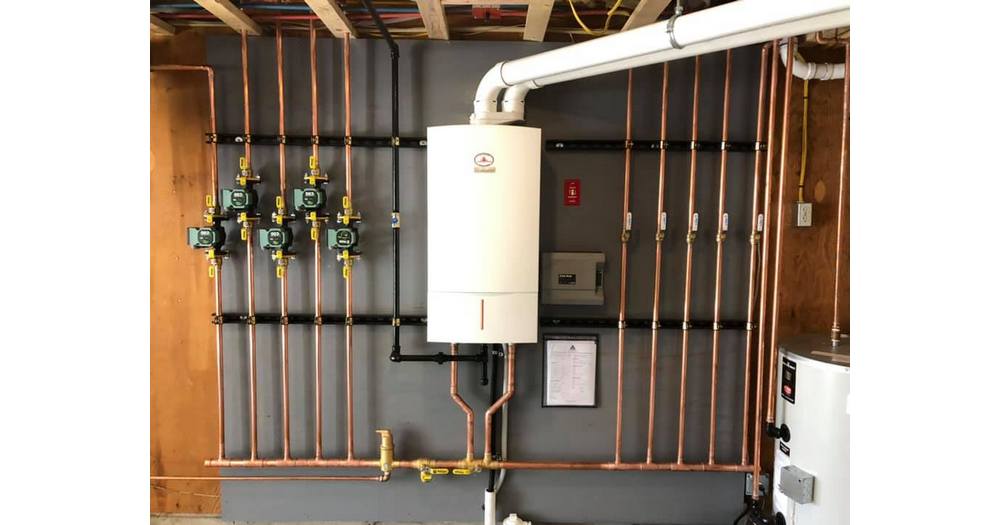
Hydronic systems are gaining steam (so to speak) in many new and exciting ways. The following are three main trends in hydronics experiencing growth:
- Efficiency, Efficiency, Efficiency
In the face of global climate change, industries at large are working to innovate and move toward high efficiency for anything and everything in HVAC — and customers are seeking ways to individually minimize their own carbon footprints.
Traditional fossil fuel-powered atmospheric boilers have efficiency in the 70-80% range. While it’s true there are still a lot of cast iron boilers in use in the U.S., the industry scuttlebutt says the federal government will stop allowing them to be sold soon — possibly within the next 5-10 years.
With the old cast iron boilers out the door, a new wave of boilers is taking center stage. Today’s modulating condensing boilers operate at least in the low 90% range for efficiency, with some reaching the very high 90% range. Not only does this make these hydronic heating systems a viable option to consider, but they also function in a way that is more economical and more consistently comfortable. This is done through the outdoor reset and indoor reset feature. The boiler will look at the air temperature (either outside or inside the house) and make incremental changes to the boiler rate depending on temperature.
The old cast iron boilers were binary, either off or on. When a building called for heat, the radiators turned on full blast, pumping 170 F water through the pipes. With new condensing boilers, if it registers 55 F outside, it doesn’t have to get as hot. It can heat water to 110 F and still make a building comfortable in no time. Indoor resets can tell if the temperature is not recovering quickly, the thermostat can figure out that it must be cold outside and make the adjustment on the fly. This can only be done with a condensing boiler.
- Combinations with electrification
Electrification is another trend becoming more prevalent as municipalities seek ways to reduce reliance on fossil fuels. Some regions are even seeing bans on the use of natural gas for everything but cooking in new developments.
One way contractors are providing efficient and effective all-electric HVAC systems is to combine heat pumps with electric boilers for radiant floor systems. These combined solutions use refrigerant in the heat pumps to cool when its warm out, but also to heat the water in the radiant floors when it’s cold. If the temperature drops lower than the heat pumps can manage efficiently, then the electric boiler will kick in as a backup.
- Breathe easy with hydrogen
In geographies that see more extreme temperature fluctuations, such as the Northeast, Midwest and Mountain states, customers may still prefer fire-based systems as opposed to all-electric. This is particularly true in older buildings or homes where the insulation is not as robust as today’s builds — they would need something that delivers heat with combustion because the heat loss is so high.
A potentially game-changing trend being explored is the use of hydrogen as a fuel for boilers. Forward-thinking manufacturers are experimenting with new designs and planning for the hydrogen revolution.
The benefits of using hydrogen instead of natural gas are many. Hydrogen is considered a renewable resource because it can be produced using solar, water and wind power. On top of that, it burns completely clean with no emissions — other than pure water. By moving to hydrogen, today’s heating systems, which are one of the largest sources of carbon emissions, can have their carbon footprint instantly and dramatically reduced.
So far, however, the use of hydrogen in hydronic systems has been limited due to the lack of an affordable and reliable means of storing and distributing the gas. That said, for some boilers, it would entail a simple swap of a few components to enable them to run on hydrogen as opposed to natural gas or home heating oil.
Hydrogen really is the future, and it’s not just in fuel-burning applications. Advancements using hydrogen to generate electricity with fuel cells is seeing massive progress in areas, such as transportation. Batteries are not a viable long-term solution, particularly in trucks and heavy equipment, due to size constraints and the limited supply of natural resources needed to make batteries. As such, hydrogen-based fuel cells look to be a primary solution.
As electrification evolves and improves in the automotive space, which will likely drive the infrastructure needs, the use of hydrogen will quickly spread to make HVAC systems, including hydronic systems in homes and businesses around the world more efficient and much cleaner, which is great for families and the environment.
Bill Staiger is a regional sales manager at Bosch Thermotechnology and has been with the company for 26 years. He is responsible for sales and service support of boilers and tankless water heaters in the Midwest.


